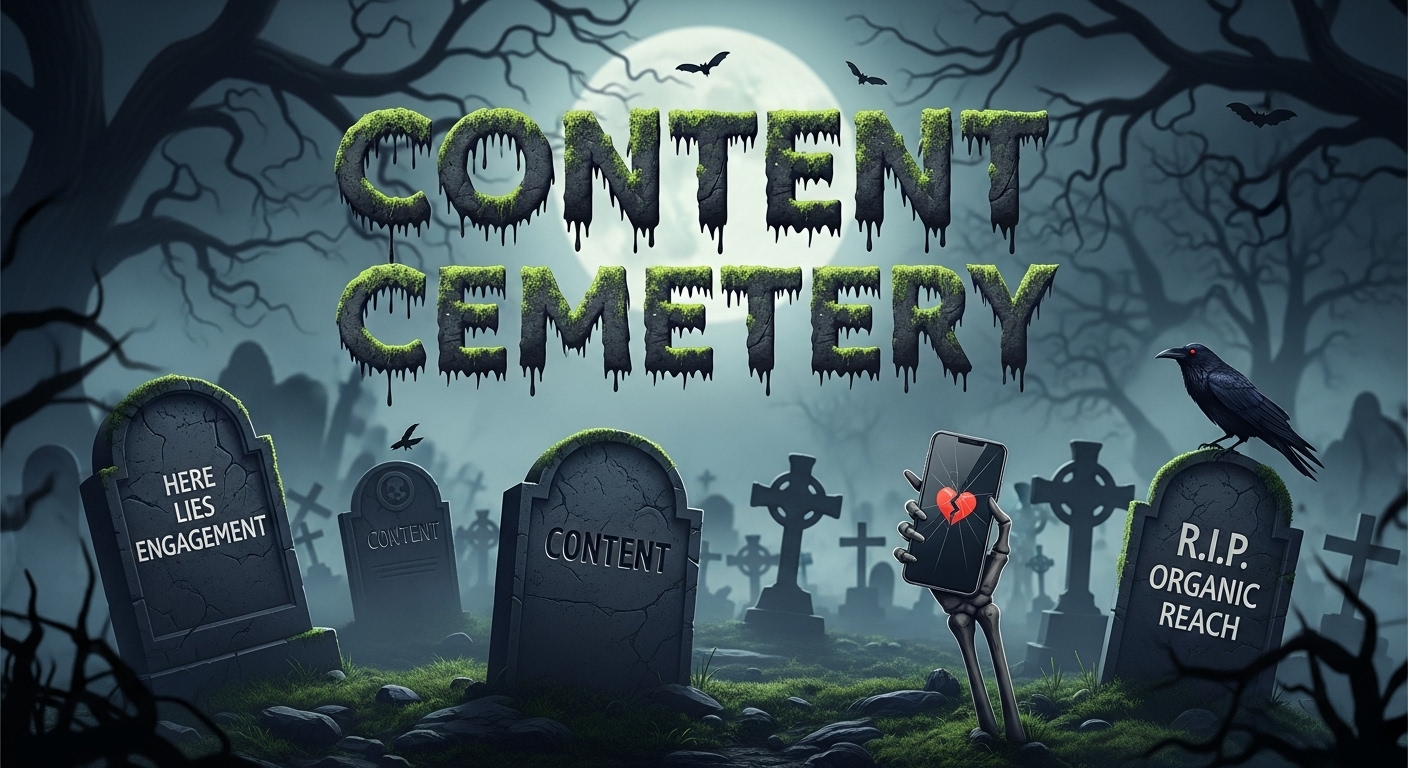
Answering a Higher Content Calling: Prioritizing Content Marketing Outcomes Over Outputs at Scale

Content and content marketing are simply strategies. A strategy, by definition, explains how a higher-level outcome or objective will be met. These can include acquisition, conversions, retention, lifetime value, and so forth. But even those content marketing outcomes serve a higher master, and that master typically has a dollar sign attached. Long-term content success means feeding the company’s bottom line, and all efforts flow down to financial success and customers: getting them, keeping them, growing them. In other words, content must be tied to business outcomes.
Keeping an eye on that ultimate prize proves difficult when content has traditionally been bound by softer ‘vanity’ metrics like page views, shares and likes. Not that these are unimportant, but present them in a graph or pie chart to your executive leadership team and you’ll likely get a collective C-level eye roll.
That’s because those leaders seek meaningful, needle-moving activity. And the most direct way to chart that type of activity is to embrace the broadest company-wide goals and objectives by pairing content strategies with them: these support an outcomes-based strategy.
Understanding the O-Zone: Outputs vs. Outcomes
Distinguishing between outputs and outcomes is an ongoing challenge for content marketers. In early industry days, teams were actually evaluated on the volume of content produced! It is now seen that quantity of content is simply an output. Outputs are the what and the how of your content efforts. Outputs can include things like articles, pages, campaigns, videos, posts, episodes…in short: ‘stuff.’ Simply put, they are the visible manifestations of content marketing efforts. But what does all that ‘stuff’ beget? That’s where outcomes enter. Outcomes are the what for and why of content marketing.
Outputs in content
- Pages
- Videos
- Social media posts
- Blog entries
- Podcast episodes
- Webinars
- Campaigns
Outcomes in content
- Awareness
- Consideration
- Affinity
- Conversion
- Retention
- Upsell
- Lifetime Value
Beware of off-putting outputs
Outputs, believe it or not, are easy. And content marketers fall into their allure all too frequently. After all, outputs are concrete and easily quantifiable, especially today. Tally a number of blog posts, track likes on social handles, count the number of email subscribers – all are quantifiable outputs. And while outputs serve as important metrics to note, sole fixation on them leads to a myopic assessment of content marketing effectiveness.
Two other outputs also must be considered and tracked: recycle rates and duplication rates. Recycle rates means the percentage of live content that is updated, refreshed, or reused, typically without changing the platform or format. Duplication rates are the amount of similar content available on the web that only uses different URLs but by all other means is identical. The first is a thrifty, efficient, additional use of content creation by updating it with new data, new examples, and new insights, and frequently benefits SERP results by maintaining the original URL. The other is a danger to SEO, as search bots cannot distinguish which is the preferred content and may punish both.
Keep an eye on the real prize by asking if the intended goals are being achieved. In other words, focus on outcomes.
Prioritize content marketing outcomes
Advanced maturity in content marketing effectiveness is indicated by efforts that are tied to, and measured by, their relationship with those broader business goals. A shift in perspective to prioritizing outcomes is a pivotal step in evolving content marketing:
- Aligning with business outcomes. Is this content contributing to business outcomes? Alignment here ultimately elevates the content function to one viewed as much more strategic, contributing to growing the business.
- Embracing audience centricity. Internally, alignment with business priorities drives content strategy, but external requirements necessitate that content address audience needs – what matters to the audience, as addressed by the content.
- Optimization. An outcome-based approach supports actionable insights. Content intelligence may indicate certain audience needs or topics resonate better than others, while some highly viewed content may actually be eroding brand perception. Using an outcome filter, winning content can be prioritized and losing content is adapted or broomed.
- ROI. The Rosetta Stone of content marketing, ROI is a language most appreciated by C-Suite denizens. An outcomes-based approach aligns the business-enhancing outcomes with content that impacts acquisition, retention, cross-/up-selling, and overall revenues. Rather than leading with cost savings on a podcast series, speak their language by tying content to the bottom line.
Remember: Outputs represent the means, but outcomes embody the results. Aligning content initiatives with overarching business outcomes and consistently measuring them supports strategic marketing proficiency.
Scaling business outcomes
In the quest to reach the apex in business-building content efforts, an outcomes-based framework helps to scale content, particularly in the age of AI. But scaling of content for content’s sake is simply adding to the white noise in the marketplace. Generative AI, if used simply to make more content faster and cheaper, will only glut the ecosystem with a sea of sameness. The opportunity exists when technology is used, to drive to more contextual, meaningful content. Here the ‘more’ is not in volume, but in relevance. Depth rather than breadth. The ’scaling,’ then, is in scaling business outcomes – whether it be enhancing the brand, improving ROI, or building an audience. Strategy scales.
“Making more from it rather than making more of it”
AI also may allow for deeper insight into which content is doing the best job at driving toward outcomes. Once identified, the scaling can begin with those hardest-working, strategic content pieces, to be used throughout the audience journey via atomization and with incremental support. Here, scaling is extending the use of winning content, amplifying it – making more from it rather than making more of it. Less can indeed be more when content intelligence identifies that content with the ability to scale, thereby embracing the outcomes principle. Altimeter’s Agile Content System sought to address content’s ability in scaling to meet business outcomes. Knotch published its take on Altimeter’s five capabilities, including:
- Creating and Delivering Personalized Content
Prior to scaling, test the Pareto Principle, where a small amount of content drives the lion’s share of engagement. What does the top performing 20% of content – even top 5% — look like? Repurposing it to meet customer needs more definitively at points in their journeys gets at outcomes-based atomization of assets – and a more distinct experience enabled by technology and scale.
- Measuring the Effectiveness of Content
Measuring content’s effectiveness must evolve beyond web traffic and engagement. As mentioned earlier, a measurement plan must be scaled to meet broader business outcomes more directly. A scaled business outcomes framework means ensuring those content outcomes are tied to KPIs that truly reflect and align with the broader outcomes.
- Reviewing and Approving Content
As the content discipline and organization grows, so too must the approach to governance, workflows, and processes – meaning those ballooning outputs are tracked to definable and measurable outcomes. Scaling production and the corresponding time and effort to review, approve, distribute and optimize content requires strategy and technology in support of outcomes.
- Managing and Storing Content
Moving from a siloed organization where content is produced by a wide swath of departments, scale actually comes into play to help focus outputs on a centralized platform, accessible and actionable to all with an open view to stop duplicative efforts and achieve higher productivity. Scaling how content is stored and managed impacts the ultimate outputs of a distributed content approach.
- Organizing to Scale Content Production and Impact
Scaling content for ultimate outputs also means organizing the content discipline in a model that scales content strategy expertise and creative acumen, flowing out to channels or structure that provides audience touches in a customer-centric manner. The growing maturity of the content organization means it must evolve as it scales, again with the goal of seeking outcome-based results, not simply outputs. Favoring an outcomes-based approach, aligning content strategies with high-level business objectives, and using content intelligence and technology, strategically places savvy content marketers on the path to content maturity and business value. Scaling these through strategy, tools and organization, aligns content with outcomes. Want to learn more about taking the road to outcomes over outputs? Schedule a short demo call with our team here.
Become a thought leader
Become a thought leader
Trusted by the largest (and now smartest) brands in the world.
“Before Knotch we did not understand what content was driving business results. Now we understand which content moves the needle. Knotch’s cohesive reporting and insights paint a real picture of what’s happening on our website instead of the patchwork quilt that comes from a Google Analytics approach. With Knotch we have been able to re-prioritize ad spend, route better leads to our SDR team, and inform our content development initiatives.”

"The Knotch platform ensures that we deliver high-performing content tailored to young home shoppers, enhancing their experience and driving better business outcomes.”

"Our partnership with Knotch has been highly successful, empowering us to leverage data-driven insights and refine our content strategy.”









